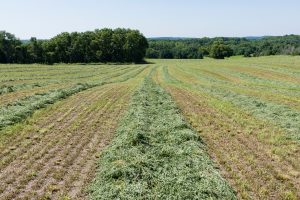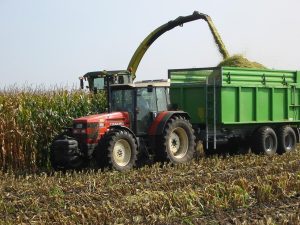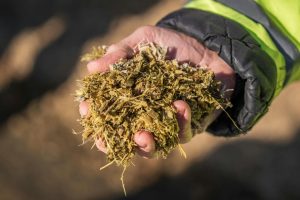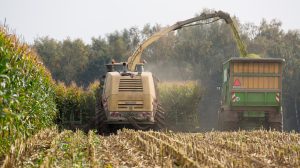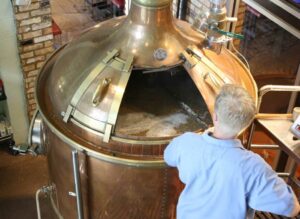Álvaro García
With rising uncertainty in the global soybean market, especially due to ongoing tariff tensions with China, many livestock producers are rethinking their crop rotations. Rather than sticking with soybeans, some are turning to alternative forages to reduce exposure to volatile commodity prices. At the same time, replanting corn after corn brings well-known agronomic risks: increased disease pressure from Goss’s wilt and northern corn leaf blight, heavier insect loads, higher nitrogen demands, and a greater chance of compaction and reduced yields. These challenges are making small grains more attractive as part of a more resilient forage strategy.
On many farms, these small grains are seeded after corn or sorghum as part of a double-cropping system. They help with forage inventories, support soil health, and add flexibility to crop rotations. Once established, these crops are typically ensiled, but producers still face a critical question: when is the best time to harvest them, boot stage for quality, or soft dough for yield?
Researchers at Virginia Tech studied several small-grain varieties grown across multiple regions comparing yield, nutritional composition, and how the different harvest stages affected dairy cow rations under a range of feedstuff price scenarios.
Balancing yield and quality
Choosing the harvest stage for small grains means trading off between forage volume and feed quality. This 2025 Virginia Tech study highlighted just how much this decision can impact both forage utility and economic return.
Harvesting at the soft dough stage resulted in impressive dry matter yields—often two to three times higher than cutting at the boot stage. This later timing makes sense when the goal is to maximize tonnage, reduce harvesting cost per ton, or stockpile silage during forage shortages. But there was a trade-off, crops harvested at the boot stage delivered significantly better forage quality, with higher crude protein, lower fiber content, and superior digestibility.
As small grains mature, their fiber becomes more lignified and less available to rumen microbes. The data confirmed this trend: at the soft dough stage, NDF digestibility declined, protein content dropped, and overall digestible energy decreased. For high-producing cows, these differences matter. Lower-quality forage can limit energy intake, reduce milk output, and challenge metabolic health. In short, later harvests mean more bulk but less nutritional value per kilogram of dry matter. The ideal harvest window depends on whether you’re prioritizing forage volume, nutrient density, or rotation timing. Keep in mind that harvesting at soft dough could delay the planting of your next crop for several weeks, which may limit your total annual forage yield.
What about costs?
Beyond yield and quality, economics play a central role in forage decision-making. With corn prices around $4.30 per bushel and soybean meal near $300 per ton, producers are re-evaluating how to stretch feed resources without sacrificing cow performance.
Using a ration formulation model, these Virginia Tech researchers simulated diets for lactating cows under various feed price and availability scenarios. When corn and soybean meal were cheap, corn silage remained the most economical forage, consistently outperforming small-grain silages on cost and nutrient balance. In these scenarios, the model typically excluded small grains altogether.
But when feed prices rose, or when corn silage was in short supply due to weather or limited storage, the picture changed. Small-grain silages, especially those harvested at soft dough, became a more cost-effective option. The higher yields at this stage reduced the cost per ton of forage and helped fill ration gaps when corn silage was limited. Interestingly, the software didn’t always prefer one maturity stage over the other. The inclusion of boot vs. soft dough silage varied by species and diet formulations. Still, when forage supplies were tight, the higher-yielding soft dough silage was more often selected, even with slightly lower nutrient density.
So in summary, small-grain silages may not replace corn silage under normal conditions, but they can play a valuable economic role when commodity prices surge, or forage inventories are stretched.
Practical implications
Choosing the right harvest stage for small grains affects more than just quality and yield, it can shift the entire cropping calendar. Waiting until soft dough may delay planting of the next crop by three to six weeks depending on local weather and growing conditions. For farms relying on double-cropping, that delay can reduce total forage output for the year, particularly if the summer crop misses its optimal planting window.
From a feeding perspective, harvesting at boot stage delivers higher-quality silage with more protein and energy, ideal for high-producing cows, but comes at the cost of lower yields. On the other hand, soft dough harvest yields significantly more tonnage, which can help lower ration costs when feed prices are high or corn silage is in short supply, though with a trade-off in nutrient density. Ultimately, the best decision will depend on your herd’s nutritional demands, forage inventory, and your overall crop rotation goals.
The full list of references used in this article is available upon request.
© 2025 Dellait Knowledge Center. All Rights Reserved.


